Is there a false boletus? Mushrooms twins
Some mushroom lovers are afraid of poisoning with false boletus. Others generally doubt that false boletuses are in reality. Which one is right? Such a species does not really exist.
All boletus "twins" are edible and pose no health hazard. Let's see how this mushroom differs from each of them.
- Differences between boletus and boletus: a red cap, a thicker leg, the flesh of the cap is denser, turns blue when broken throughout the mushroom and quickly turns black.
- In a pine-shaped porcini mushroom: the leg is less thick, there are no scales on it.
- From the Polish: the red color of the cap (the Polish has a deep chestnut), the flesh is tougher. Polish is widespread only in oak groves and occasionally in "conifers", and aspen boletus is ubiquitous.
Common boletus and its photo
Category: edible.
The cap of the common boletus (Leccinum aurantiacum) (5-28 cm in diameter): brown with shades of red or orange. It has the shape of a hemisphere and can be easily separated from the leg. The peel is removed with difficulty and only with pieces of pulp.
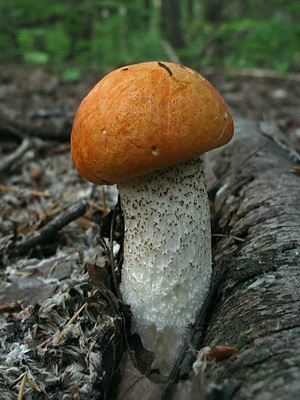
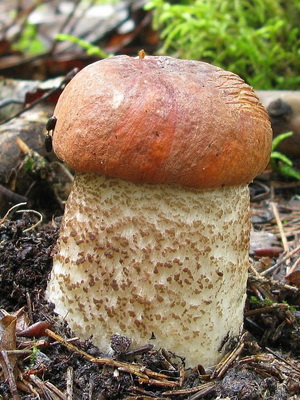
Leg (height 4-18 cm): solid gray or off-white. A photo and description of the leg of an ordinary boletus is similar to the leg of an oak boletus - the same fibrous scales are located on it, which eventually become almost black.
Tubular layer: loose, white, yellowish or olive. Old or wormy mushrooms have a dirty gray or brownish color.
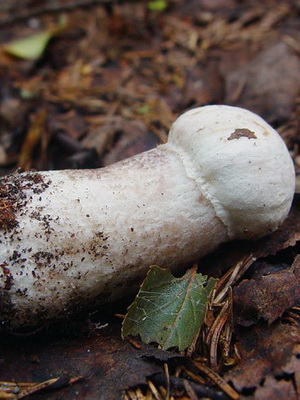

Flesh: fleshy and dense, elastic in a young mushroom, soft and loose in an old one. On the cut, it is immediately white, after a few minutes it becomes bluish, and later turns black. It does not have a distinct aroma.
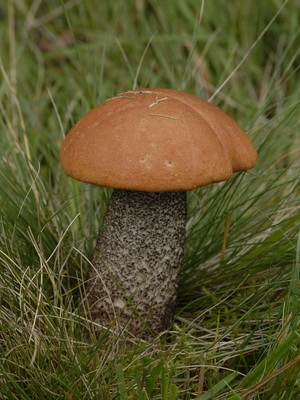
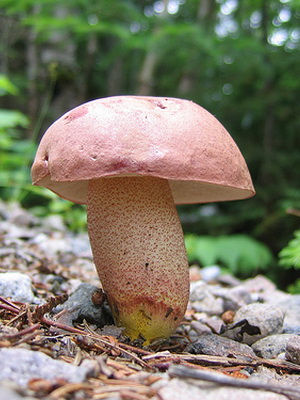
Twins: edible yellow-brown boletus (Leccinum versipelle) and colored-footed boletus (Tylopilus chromapes). The yellow-brown has a lighter cap and flesh, which first turns pink, then turns blue on the cut, and the colored-legged has a yellowish leg.
When it grows: from early June to mid-October in many countries of Eurasia, the Caucasus, the Far East, the Urals and Western Siberia.
Where can you find it: in deciduous and mixed forests. Prefers proximity to aspens, willows, birches, oaks and poplars. Never grows next to conifers. Occasionally it can be found in the glades, not far from the aspen forests.
Eating: in almost any form, only when frying, drying and cooking it darkens strongly.
Application in traditional medicine (data not confirmed and not passed clinical studies!): In the form of a tincture - an excellent remedy for cleansing the blood and skin, which is considered effective against acne.
Other names: krasnik, krasyuk, red mushroom, redhead, aspen.
Depending on the time of its appearance, the people call the common boletus "spikelet" (if it is an early mushroom), "stubble" (as the later boletus is called), and closes the season with "deciduous".
Culinary value of boletus
This is a favorite type of mushroom to cook at home. Culinary specialists in catering establishments prepare boletus, like other edible mushrooms. For the human body, in terms of quality and nutritional value, these are the second after porcini mushrooms. Boletus flesh turns dark when cooked.
Due to a number of poisonings and difficulties with species identification, some types of boletus in Europe are considered unsafe for consumption. In Russia, mushrooms do not cause any concern, they are fried, boiled, salted, dried for cooking in the winter. Uncooked or undersalted specimens cause vomiting or other negative effects on digestion. Aspen mushrooms cause nausea when eaten raw.
Young aspen mushrooms are prepared in a variety of ways, old specimens are dried, crushed and used as a seasoning if the harvest is poor.
These mushrooms are not suitable for cooking together with other types of mushrooms due to the density of the pulp. Aspen mushrooms are not cooked up when other mushrooms are already completely ready for consumption.
Boletus white (Latin Leccinum percandidum)
Name Boletus is white.Latin name: Leccinum percandidum.Other names: White aspen.Department: Basidiomycota.Class: Agaricomycetes.Order: Boletovye.Family: Boletovye.Genus: Leccinum.
The species is listed in the Red Book.
Edible mushroom.
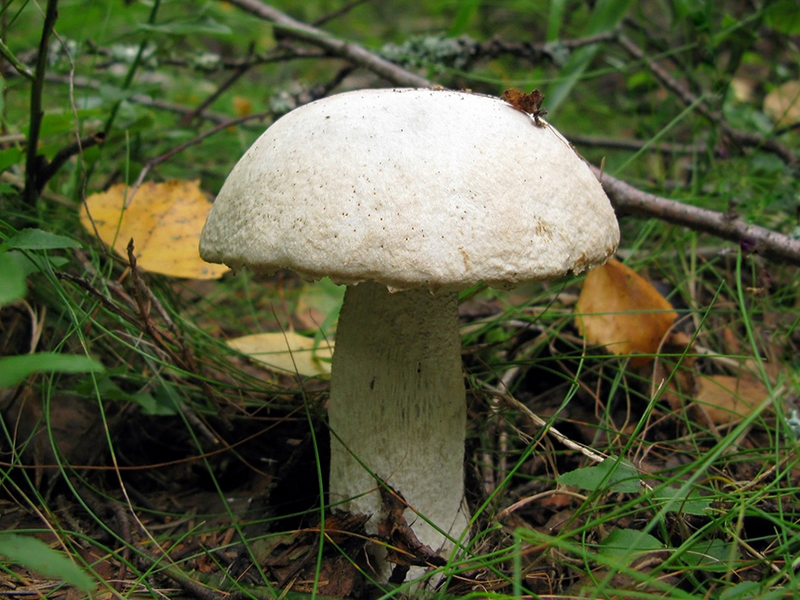 Name Boletus is white.Latin name: Leccinum percandidum.Other names: White aspen.Department: Basidiomycota.Class: Agaricomycetes.Order: Boletovye.Family: Boletovye.Genus: Leccinum.
Name Boletus is white.Latin name: Leccinum percandidum.Other names: White aspen.Department: Basidiomycota.Class: Agaricomycetes.Order: Boletovye.Family: Boletovye.Genus: Leccinum.
The species is listed in the Red Book.
Edible mushroom.
Leg
51-250 mm high, 14-51 mm thick, cylindrical, without cavities, solid, often thickened at the base, white with uniformly growing scales, usually the same color, which become brownish or grayish as the fungus matures.
Hat
41-152 mm in diameter, in young fruiting bodies hemispherical, later cushion. The skin is whitish in color, slightly hanging over the tubular layer, having pink or greenish light shades, later it becomes light yellow. The surface is slightly velvety or bare.
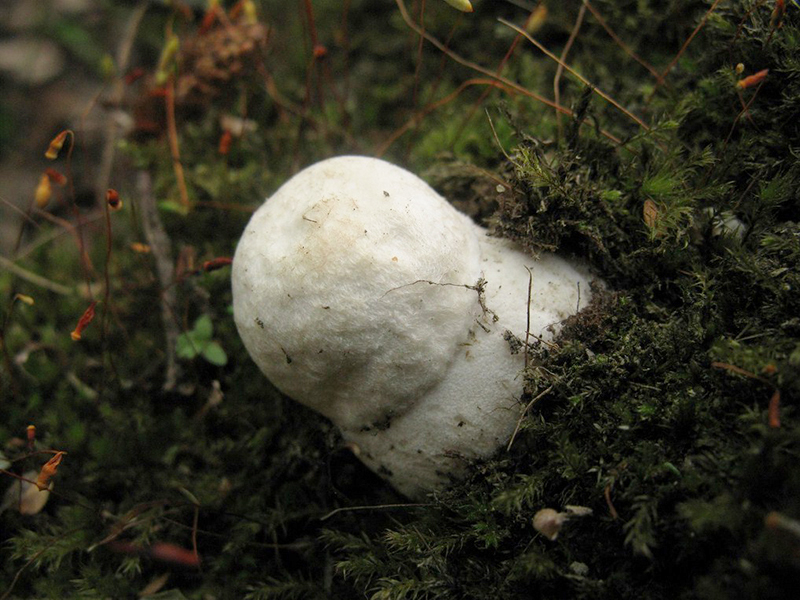
Hymenophore
Notched, or slightly adherent, whitish or yellowish, gray in old mushrooms. The pores are small, the tubes turn slightly pink when damaged.
Pulp
Dense, white, often blue-green at the base of the peduncle. When damaged, it turns blue, then oxidizes to black. Has a pleasant mushroom smell and taste.
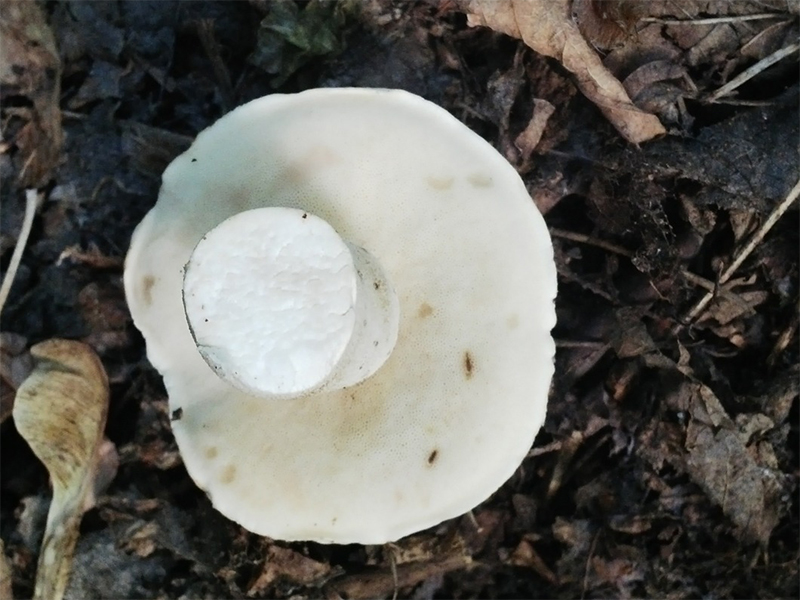
Ocher brown.
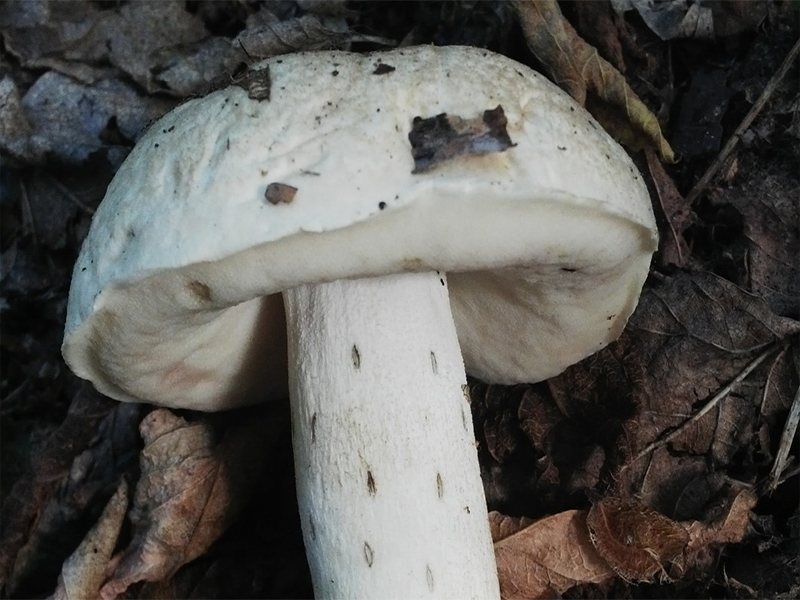
Habitat
It grows in forests with a mixed stand, adjacent to both pines and aspens. Prefers moist and shady areas of the forest. According to some reports, it can bear fruit in large groups.
The nutritional value
Suitable for cooking in various ways, as it has good nutritional properties. But do not forget that this species is listed in the "Red Book" and needs to be preserved.
Yellow-brown boletus (Leccinum versipelle)
Sininima:
- Obschinous
- Boletus red-brown
Hat:
The diameter of the cap of a yellow-brown boletus is 10-20 cm (sometimes up to 30!). The color varies from yellowish-gray to bright red, the shape is initially spherical, not wider than the leg (the so-called "brisket"; it looks, you know, quite feidist), later convex, occasionally flat, dry, fleshy. At the break, it first turns purple, then becomes bluish-black. It has no special smell and taste.
Spore-bearing layer:
The color is from white to grayish, the pores are small. Young mushrooms are often dark gray, lightening with age. The tubular layer is easily detached from the cap.
Spore powder:
Yellow-brown.
Leg:
Up to 20 cm long, up to 5 cm in diameter, solid, cylindrical, thickened towards the bottom, white, sometimes greenish at the base, deeply sinking into the ground, covered with longitudinal fibrous scales of gray-black color.
Spreading:
Boletus yellow-brown grows from June to October in deciduous and mixed forests, forming mycorrhiza mainly with birch. In young forests, it can be found in fabulous quantities, especially in early September.
Similar species:
As for the number of varieties of boletus (more precisely, the number of species of mushrooms, united under the Russian name "boletus"), there is no final clarity. The red boletus (Leccinum aurantiacum), which is allied to aspen, is especially distinguished, which is distinguished by red-brown scales on the stem, not such a wide hat span and a much more solid constitution, while the yellow-brown boletus in texture is more reminiscent of the boletus (Leccinum scabrum). Other species are also mentioned, distinguishing them mainly by the type of trees with which this fungus forms mycorrhiza, but here, obviously, we are talking about individual subspecies of Leccinum aurantiacum.
Edibility:
Excellent edible mushroom. Slightly inferior to white.
Remarks
We all love the boletus. The boletus is beautiful. Even if he does not have such a powerful "inner beauty" as the white one (although he still has some) - a bright appearance and impressive dimensions can please anyone. For many mushroom pickers, the memories of the first mushroom are associated with the boletus - the first real mushroom, not about the fly agaric and not about the russula. I remember very well how in 1983 we went to pick mushrooms - at random, not knowing the place and the road - and after several unsuccessful forays we stopped near a modest young fishing line at the edge of the field. And there!..
I think you have already guessed what we saw there. What and how much ... And that I had to drag the spare tire from the trunk into the salon, because there was no room, you guessed it too ... And that the car was so overloaded that it scratched the asphalt with its belly, I will not lie. But there was simply an inexpressible mass of aspen mushrooms! Boletus and for some reason waves. In the proportion of "one boletus for two boletus". And there was a good bucket with a little
Moreover, please note that the waves are still small
Eh! .. And where are these times? Thanks to their naive flair, the boletus are the first to leave our forests. In marching order, folding the banners ...
Similar species
The oak boletus has two related species - pine and spruce boletus. In some sources, there is a version that oak, pine and spruce species are subspecies of red boletus.
 Boletus 1-Pine 2-Spruce
Boletus 1-Pine 2-Spruce
In these mushrooms, the oak boletus is distinguished by the brown color of the cap (in the spruce and pine - red), as well as the color of the scales (in the oak boletus they are reddish-brown). Distinguishing the species of boletus does not make much sense, except for the scientific, since they are all edible and do not differ in taste.
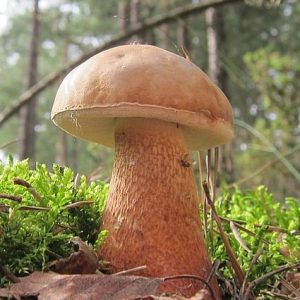 Gall mushroom
Gall mushroom
The only thing that should be distinguished from the oak boletus is the Gall mushroom. It is almost the same color, but its leg is often curved (in contrast to the straight leg of the boletus). When cut, the gall mushroom turns pink, which never happens in the boletus. They cannot be poisoned, but it is so bitter that it is impossible to eat it.
Black-scale boletus
On the Internet, you can find a mention of such a species as the black-scaly boletus (Leccinum atrostipiatum). Its description is very similar to the description of the red boletus, but black-scaled is most often found in sources from North America, and therefore it is likely that it grows there. On the Russian sites, there is no information about the places of its growth, and most of these sites cannot be considered authoritative resources in the field of mushrooms. Based on this, I decided not to include this boletus in this selection of species, but it was still necessary to say about it.
Why does the boletus turn blue (darken) on the cut
The transformation of the white flesh of the boletus into blue-violet on the cut occurs as a result of the oxidation process, which consists in the interaction of oxygen with the substances contained in the mushroom. Similar reactions are also typical for fruits and some vegetables, for example, if you cut an apple, then after a while its pulp will acquire a brownish tint. This answer will be enough if you do not want to go into the details of chemical reactions. Still, I would like to receive more detailed information on this issue.
After reading various literature, you can find out that the boletus contains a certain pigment - variegated acid. The composition of this pigment includes substances of the phenolic group, which, when interacting with oxygen, are oxidized to the quinomethide anion, which has just a blue color, which is the very reason for the appearance of a violet-blue color on the cut of boletus pulp. It is worth noting that in its pure form, variegated acid does not acquire a blue color so quickly, and therefore, in addition to the effect of oxygen, the enzymes contained in the pulp of the mushroom also have an effect, they accelerate the process of its darkening on the cut.
Why boletus is useful
In addition to their incredibly beautiful appearance, the boletus boasts a rich set of nutrients. They contain: Vitamins (PP, E, C, B1, B2). Minerals (potassium, sodium, phosphorus, iron, calcium, lithium). It is noteworthy that in terms of the content of vitamin "PP", aspen mushrooms are not inferior to such products as liver and yeast, and the amount of vitamin "B" in these mushrooms is comparable to that of cereals.
The boletus contains many proteins, which are digested, although worse than proteins of animal origin, but at the same time are a source of a number of essential amino acids. The largest amount of proteins is concentrated in the caps of young mushrooms. The use of boletus in food will be useful for people suffering from inflammatory diseases, anemia, as well as in the recovery period after infectious diseases.
Boletus yellow-brown (Latin Leccinum versipelle)
Name Boletus is yellow-brown.Latin name: Leccinum versipelle.Other names:Department: Basidiomycota.Class: Agaricomycetes.Order: Boletovye.Family: Boletovye.Genus: Leccinum.Edible mushroom.
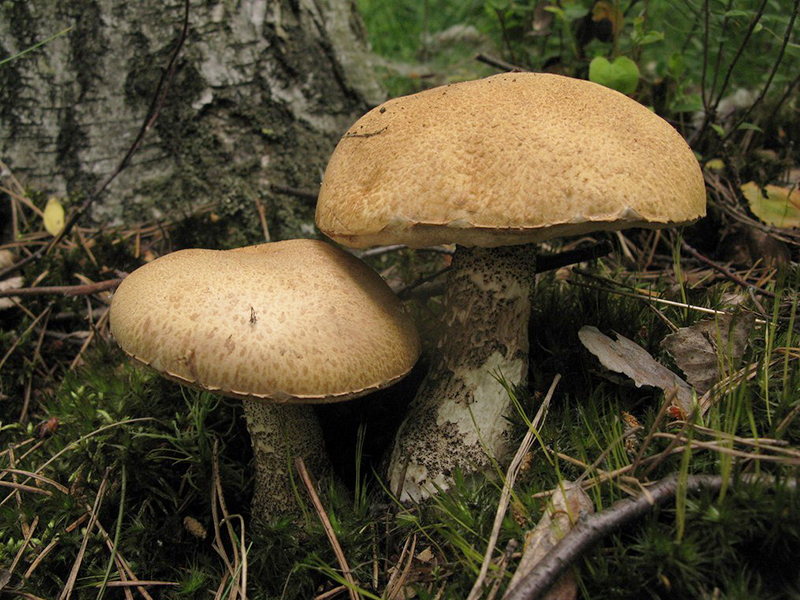 Name Boletus is yellow-brown.Latin name: Leccinum versipelle.Other names:Department: Basidiomycota.Class: Agaricomycetes.Order: Boletovye.Family: Boletovye.Genus: Leccinum.Edible mushroom.
Name Boletus is yellow-brown.Latin name: Leccinum versipelle.Other names:Department: Basidiomycota.Class: Agaricomycetes.Order: Boletovye.Family: Boletovye.Genus: Leccinum.Edible mushroom.
Scientific synonyms
Krombholzia aurantiaca
Krombholzia rufescens
Boletus roseotinctus
Boletus rufescens
Leccinum testaceoscabrum
Leccinum roseotinctum
Leg
81-221 mm long, 12-46 mm thick, cylindrical or thickened towards the base, white, light gray or with a yellow tint, the surface is covered with dark (gray, black) scales.
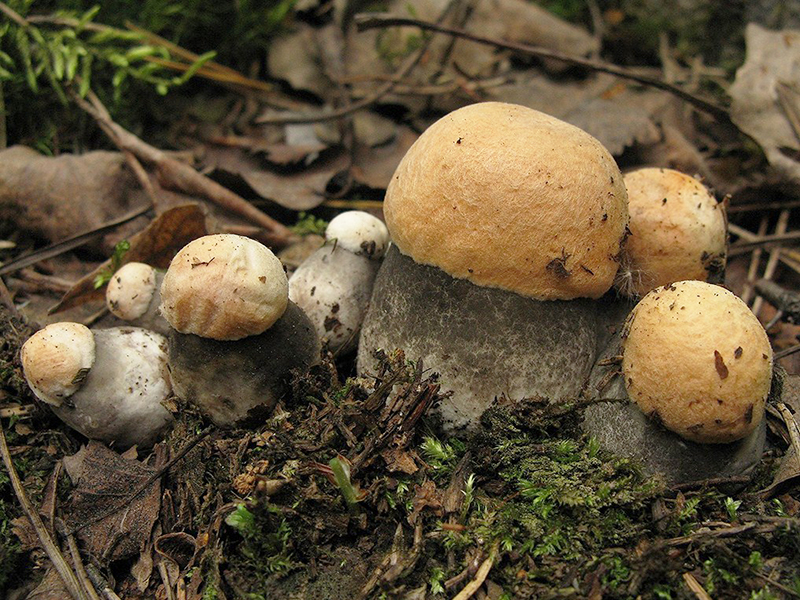
Hat
80-180 mm in diameter, hemispherical at first, becomes flat-convex as it matures. At the edges of young fruit bodies, the skin hangs down a little, then disappears. The velvety surface has a yellowish, yellow-cream, brownish color. Flakes of a darker color are also noticeable on the surface.
Hymenophore
Notched, 11-11.5 mm thick, off-white, olive-gray. The pores of young mushrooms are gray, then light brown, small.
Whitish, soft, color does not change when damaged. No pronounced taste and smell.
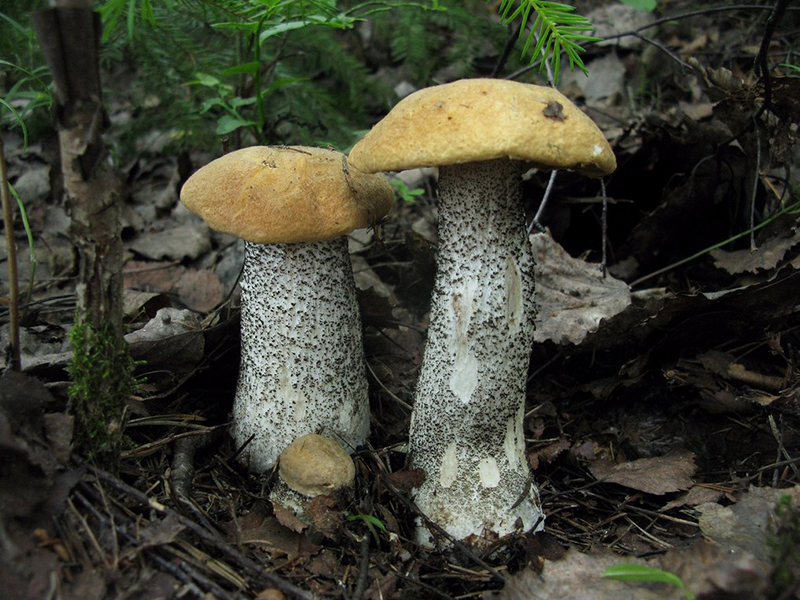
Habitat
It grows with birch and mixed stands. This species is one of the few boletus that forms mycorrhiza with birch. Prefers dry, non-acidic soil. Grows singly, or not in large groups.
The nutritional value
Quite a valuable mushroom, like all mushrooms of the family, by the way. It is eaten in various forms, from fried to pickled.
How to determine that a mushroom is a boletus
The leg is stocky, the body of the mushroom is dense, the cap is red. The mushroom tastes good, edible. All mushrooms at different stages of life do not radically change their appearance. But young and old specimens of boletus are strikingly different. Young mushrooms have a cap, which is “pushed” over a columnar leg. It is fully attached to the stem. In adult mushrooms, the cap and leg are similar in shape to "fungi" that are installed in playgrounds. The hat is wide, protects the leg from rain and sun.
Hat colors
Avoid old boletus boletuses in which the shade of the cap has completely changed. The surface texture of the cap varies from wet and viscous to greasy or dry, from felt to rather granular to the touch. The hat is brittle. The color changes, because mushrooms are living organisms and they do not always follow the encyclopedic rules! But in general, a particular type of boletus has a fairly consistent color range.
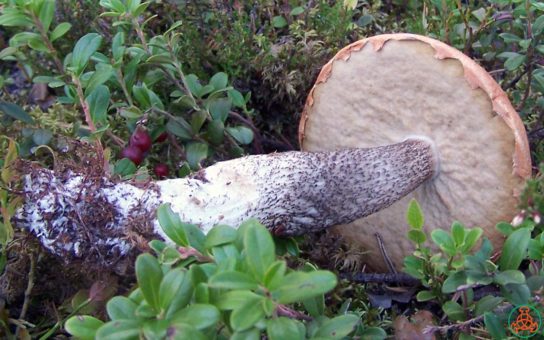
The cap in healthy fungi not susceptible to parasite infestation is orange-red, up to 20 cm in diameter. The pulp is white, the sites of damage are at first burgundy, then become grayish and purple-black. The bottom of the cap has small whitish pores that turn bluish brown when broken.
Leg
Its height is 10-18 cm, thickness is 2-3 cm, after damage it acquires a greenish-blue tint.Healthy boletus boletuses have whitish legs with short, rigid projections, which become brown or blacken with aging. Such a color change should not be scary, this is the norm for boletus. Black does not contain hydrocyanic acid or other poisons, it is safe for humans when properly prepared and cooked.
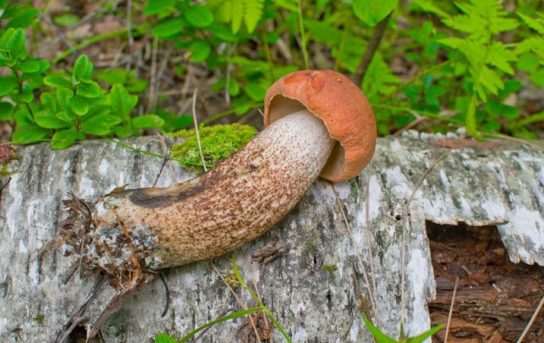
The leg sinks deep into the ground, the main part is on the surface, but not all. Therefore, when collecting, cut off the leg as close to the ground as possible or twist the mushroom higher in order to raise it above the surface, trying not to damage the mycelium.
Aspen mushrooms - benefits and medicinal properties
Boletus boletuses are stewed and boiled, marinated and fried, frozen and dried - in any form, these gifts of the forest are good and tasty. So that the aspen mushrooms do not darken (do not turn black), they are soaked in a 0.5% citric acid solution before cooking. What are the benefits of boletus for the human body?
- As with most mushrooms, 90% of the boletus mass consists of water. Proteins make up about 4%, fiber - up to 2%, carbohydrates account for 1.5%, fat contains no more than 1%, and 1.5% of the composition of the mushroom is minerals.
- The calorie content of the boletus is only 22 kcal, so this mushroom can be considered as one of the components of the diet. Combined with a zero glycemic index, these red mushrooms are recommended for people with diabetes.
- Boletus protein contains a significant amount of amino acids essential for humans, which are absorbed by the body by 80%. By this useful property, mushroom proteins are similar to animals, therefore broth from young boletus boletuses is deservedly compared with meat broth.
A significant amount of vitamins was found in redheads: in terms of the content of vitamin B, boletus mushrooms can be compared with cereals, and the amount of vitamin PP is the same as in the liver. The boletus also contains vitamins A and C. The predominant mineral composition of the redhead is potassium, to a lesser extent, the mushroom pulp contains magnesium, phosphorus, calcium, sodium and iron.
- Scientists have proven that regular consumption of boletus helps to eliminate toxins and toxins from the body.
- Boletus broth will help restore immunity after viral diseases, and also has a beneficial effect on blood composition in case of anemia.
The boletus mushroom is the most popular among lovers of quiet forest hunting on autumn days. He has an impressive size, bright color of the cap and is clearly visible against the background of green grass. But at the time of leaf fall, it will not be so easy to find it. Boletus mushroom species include a wide variety of colors, but basically all of them are similar to the color of a yellowed or reddened aspen leaf. The article not only tells about what it looks like, but also gives advice on where to look. Where this or that species grows is indicated in each description.
Boletus false - description and photo. How to distinguish a boletus?
Boletus mushroom is not only one of the most beautiful mushrooms, but also the safest. Almost without exception, aspen mushrooms are edible, and knowing the mushrooms by sight, they can be collected safely without fear of poisoning. Although cases of poisoning with raw and boiled boletus have been reported in North America, there is currently no exact information which of the boletus species growing in America are poisonous.
And yet, mushroom pickers have questions about whether there is a false boletus, what it looks like and how to distinguish an edible boletus from a false one. In fact, false boletuses do not exist. The only thing is that the boletus can be confused with the gall mushroom (bitter mushroom), which, in principle, does not look like a real redhead.
The gall mushroom has a bitter taste, turns pink or turns brown on the cut and has a brown mesh on the stem. The boletus has a pleasant taste, black scales on the stem and turns blue on the cut.
Below is a photo of an inedible gall fungus.Read more on how to spot a gall fungus in this article.
Gall mushroom
Boletus - photo and description. What does a boletus look like?
All types of boletus boletus are characterized by a bright color of the cap, a stocky leg and a dense structure of the fruit body.
The diameter of the cap, in accordance with the species, can be from 5 to 20 (sometimes 30) cm. At a young age, almost all types of redheads are distinguished by the hemispherical shape of the cap, which tightly squeezes the top of the leg. The cap of a young red mushroom looks like a thimble, worn on a finger. As the boletus grows, the cap acquires a convex pillow-like shape, in completely overgrown mushrooms it is noticeably flattened. The skin covering the cap is usually dry, sometimes velvety or felt; in some species it hangs down from the edge of the cap and is not removed in most mushrooms.
The high (up to 22 cm) leg of the boletus has a distinctive, clavate shape with a pronounced thickening at the very bottom. The surface of the leg is covered with small scales, usually brown or black.
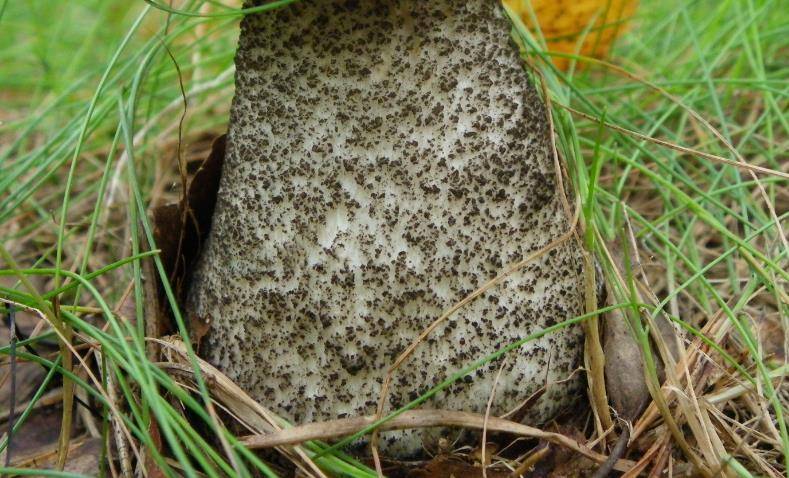
The porous layer under the cap, characteristic of all members of the Boletaceae family, has a thickness of 1 to 3 cm and can be pure white, grayish, yellow or brown.


The photo shows that the boletus turns blue on the cut
Redhead mushrooms have mostly smooth fusiform spores, and the color of the powder obtained from mushroom spores can be ocher-brown or olive brown. The flesh of the cap of the red mushroom is fleshy, elastic, with a dense structure, in the stem it is distinguished by the longitudinal arrangement of the fibers.
Initially, the flesh of the boletus is white, but immediately turns blue on the cut, and then turns black.
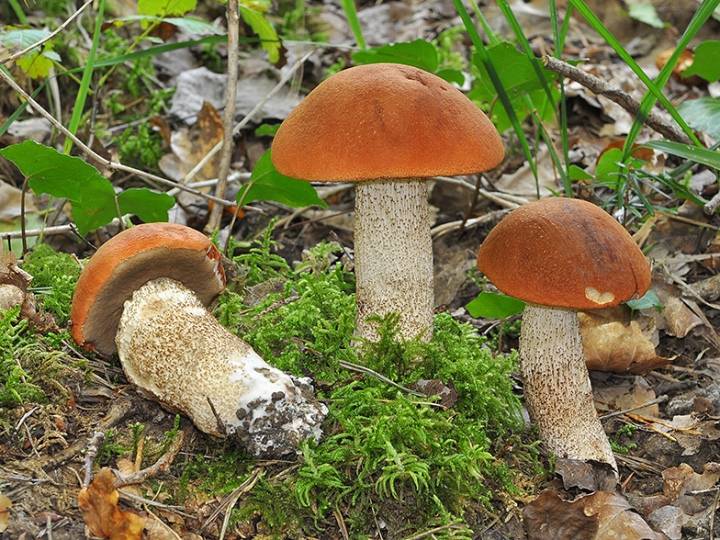
Where is Leccinum oxydabile found
The pink boletus is common in mainland Europe, from Scandinavia to the Mediterranean Sea and westward through the Iberian Peninsula, and is also harvested in North America.
Taxonomic history
The pinking boletus was described in 1783 by the French naturalist Pierre Bouillard, who gave it the binomial scientific name Boletus scaber. The current common scientific name is used after the publications of the British mycologist Samuel Frederick Gray in 1821.
Etymology
Leccinum, the generic name, comes from an old Italian word for fungus. The specific epithet oxydabile means "oxidizing", referring to the pinking surface of the legs of the species.
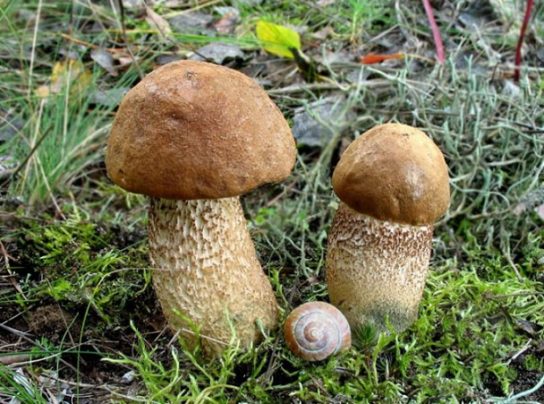
Primary processing and preparation
Some housewives have a question about what to do with blue mushrooms that differ from the boletus they saw in the photographs? After collecting the boletus, you need to immediately process and cook! If the mushrooms have lain for more than two days, even in the refrigerator, such specimens can only be thrown away.
If you plan to cook them for salting, pickling or frying, they must be washed first, then cleaned and removed from possible worm damage, and then boiled in two waters. For drying, do not wash, but be sure to clean, best of all with a brush.
Small fruiting bodies are well marinated or salted, strongly grown - preferably fried, stewed or dried. Mushrooms have excellent taste, go well with other products, in particular potatoes, buckwheat and rice. Good in soups and salads. You can "roll" mushroom caviar.
When processed, all aspen trees darken, when dried they practically turn black, in contrast to white ones, which do not change color when dried.
Spreading
These mushrooms grow practically throughout the entire forest area, from Europe and the Caucasus to the Far East and Western Siberia. They are collected throughout the summer, from early June to September inclusive. Some species delight lovers until the first frost. Grows especially well in the wet season.
Mushrooms can take a fancy to different places of mixed and deciduous forests. One thing is for sure - where the boletus grows, cool breezes always blow, and there is no direct scorching sun.More details about the preferences of the most famous species can be found below.
| Views | Preferred forest habitats | Special places of growth | Peculiarities |
|---|---|---|---|
| White | Deciduous and mixed | any wet places | representative from the Red Book |
| Yellow-brown | Birch, pine and mixed | under the fern leaves | grows until the first frost, at the beginning of September there can be an unusually large number in young forests |
| Red | deciduous, mixed and pine forests, young aspen forests | glades, forest roadsides, in the grass | comes out in three "waves": from late June to early July a little, from mid-July to early August actively, from mid-August long and abundant |
What inedible mushroom can be confused with boletus?
The boletus is very unique in its appearance, and therefore it is quite difficult to confuse it with other mushrooms. But inexperienced mushroom pickers may still have some difficulties with its definition. In nature, there is perhaps only one inedible mushroom, which bears some resemblance to the boletus, and it is called gall mushroom (Tylopilus felleus).
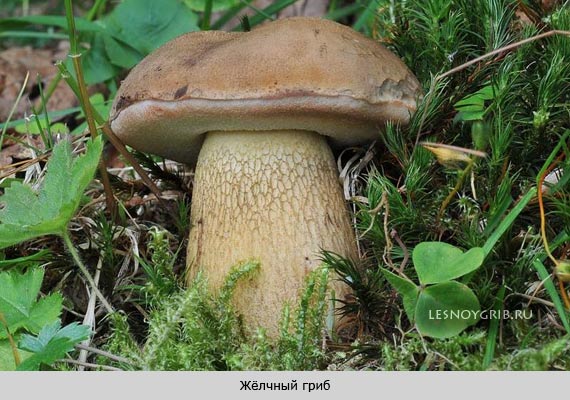
The gall fungus is not poisonous, it is simply inedible due to the very bitter taste of the pulp. Among the main differences between this mushroom and the boletus is a brown cap, a tubular layer that has a pinkish tint in adult mushrooms, as well as a leg on which there are no scales, but often there is a mesh pattern. On the cut, the mushroom does not darken, only occasionally a reddish tint may appear in the pulp. The gall fungus is quite widespread in Russia, it grows in coniferous and deciduous forests, and likes to appear at the base of trees. Most often, the gall mushroom is confused with a boletus or a porcini mushroom, but it does not have a very big resemblance to a boletus, you can see for yourself by looking at his photo.
Boletus yellow-brown, Leccinum versipelle
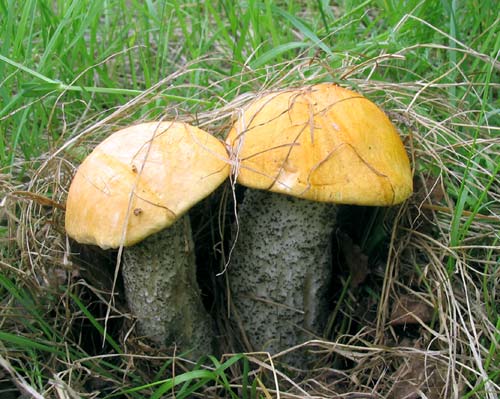
Hat: Diameter 10-20 cm (sometimes up to 30!). The color varies from yellowish-gray to bright red, the shape is initially spherical, not wider than the leg (the so-called "brisket"; it looks, you know, quite feidist), later convex, occasionally flat, dry, fleshy. At the break, it first turns purple, then becomes bluish-black. It has no special smell and taste.
Spore-bearing layer: The color is from white to grayish, the pores are small. The tubular layer is easily detached from the cap.
Spore powder: Yellow-brown.
Leg: Up to 20 cm long, up to 5 cm in diameter, solid, cylindrical, thickened towards the bottom, white, sometimes greenish at the base, deeply sinking into the ground, covered with longitudinal fibrous scales of gray-black color.
Distribution: Grows from June to October in deciduous, mixed and pine forests, forming mycorrhiza mainly with birch. In young forests, it can be found in fabulous quantities, especially in early September.
Similar species: As for the number of boletus varieties (more precisely, the number of mushroom species united under the Russian name "boletus"), there is no final clarity. The red boletus (Leccinum aurantiacum), allied to aspen, is especially distinguished, which is distinguished by lighter scales on the stem, not such a wide cap and a much more solid constitution, while L. versipelle in texture it rather resembles the boletus (Leccinum scabrum). Other species are also mentioned, distinguishing them mainly by the type of trees with which this fungus forms mycorrhiza, but here, obviously, we are talking about individual subspecies of Leccinum aurantiacum.
Edible: Excellent edible mushroom. Slightly inferior to white.
Author's Notes: We all love the boletus. The boletus is beautiful. Even if he does not have such a powerful "inner beauty" as the white one (although he still has some) - a bright appearance and impressive dimensions can please anyone. For many mushroom pickers, the memories of the first mushroom are associated with the boletus - the first real mushroom, not about the fly agaric and not about the russula.I remember very well how in 1983 we went to pick mushrooms - at random, not knowing the place and the road - and after several unsuccessful sorties we stopped near a modest young fishing line at the edge of the field. And there!..
I think you have already guessed what we saw there. What and how much ... And that the spare wheel had to be dragged from the trunk to the salon, because there was no room, you guessed it too ... And that the car was so overloaded that it scratched the asphalt with its belly, I will not lie. But there was simply an inexpressible mass of aspen mushrooms! Boletus and for some reason waves. In the proportion of "one boletus for two boletus". And there was a good bucket with a little
Moreover, please note that the waves are still small
Eh! .. And where are these times? Thanks to their naive flair, the boletus are the first to leave our forests. In marching order, folding the banners ...
What else can I say? The larvae of mushroom flies (or simply worms) eat the cap in an unexpected way: they form black cavities in it, completely filled with themselves. It's unpleasant. Although convenient. You cut out the "worm", the rest of the mushroom is yours. Unpleasant, but convenient and practical. Such are the times, such customs ...
Definitioner
- Basidia (Basidia)
-
Lat. Basidia. A specialized structure of sexual reproduction in fungi, inherent only in Basidiomycetes. Basidia are terminal (end) elements of hyphae of various shapes and sizes, on which spores develop exogenously (outside).
Basidia are diverse in structure and method of attachment to hyphae.
According to the position relative to the axis of the hypha, to which they are attached, three types of basidia are distinguished:
Apical basidia are formed from the terminal cell of the hypha and are located parallel to its axis.
Pleurobasidia are formed from lateral processes and are located perpendicular to the axis of the hypha, which continues to grow and can form new processes with basidia.
Subasidia are formed from a lateral process, turned perpendicular to the axis of the hypha, which, after the formation of one basidium, stops its growth.
Based on morphology:
Holobasidia - unicellular basidia, not divided by septa (see Fig. A, D.).
Phragmobasidia are divided by transverse or vertical septa, usually into four cells (see Fig. B, C).
By type of development:
Heterobasidia consists of two parts - hypobasidia and epibasidia developing from it, with or without partitions (see Fig. C, B) (see Fig. D).
Homobasidia is not divided into hypo- and epibasidia and in all cases is considered holobasidia (Fig. A).
Basidia is the place of karyogamy, meiosis and the formation of basidiospores. Homobasidia, as a rule, is not functionally divided, and meiosis follows karyogamy in it. However, basidia can be divided into probasidia - the site of karyogamy and metabasidia - the site of meiosis. Probasidium is often a dormant spore, for example in rust fungi. In such cases, probazidia grows with metabasidia, in which meiosis occurs and on which basidiospores are formed (see Fig. E).

See Karyogamy, Meiosis, Gifa.
- Pileipellis
-
Lat. Pileipellis, skin - differentiated surface layer of the cap of agaricoid basidiomycetes. The structure of the skin in most cases differs from the inner flesh of the cap and may have a different structure. The structural features of pileipellis are often used as diagnostic features in descriptions of fungi species.
According to their structure, they are divided into four main types: cutis, trichoderma, hymeniderma and epithelium.
See Agaricoid fungi, Basidiomycete, Cutis, Trichoderma, Gimeniderm, Epithelium.
How to collect
White boletus, listed in the Red Book, should not be collected at all. Plucking just one mushroom, a person will destroy thousands of spores, from which mycelium can develop.
As for the rest of the representatives, it is best to collect them in young deciduous forests, although they also grow in mixed ones, but in smaller quantities. In the heat and dryness, they actively "move" to the aspen forests. Each species prefers its own places of growth, as mentioned earlier.The boletus grows for 3-6 days, so if you visit the old gathering places twice a week, you can always stay with the "catch".

The description of the boletus certainly includes a bright hat, but it must be borne in mind that this is not always the case. The less sunlight falls on it, the lighter the shade can be. This fact should also be taken into account when collecting aspen mushrooms. The brightest hats can be immediately seen on the edges and in the rare aspen forests. Even beginners will not pass by such mushrooms, happily seeing the tall "handsome men" in the glades.
Collecting aspen mushrooms is not difficult, because they grow in "families" and, having seen one, you can collect, if you're lucky, a whole "cart" at once. You need to cut off at the base so as not to damage the mycelium. You should not take only old mushrooms, as they will have time to deteriorate before the mushroom picker brings them home.
